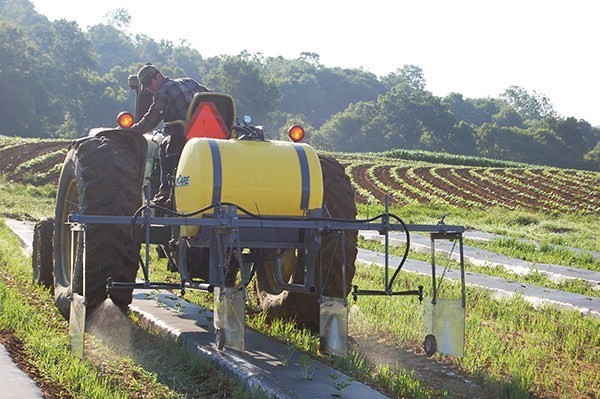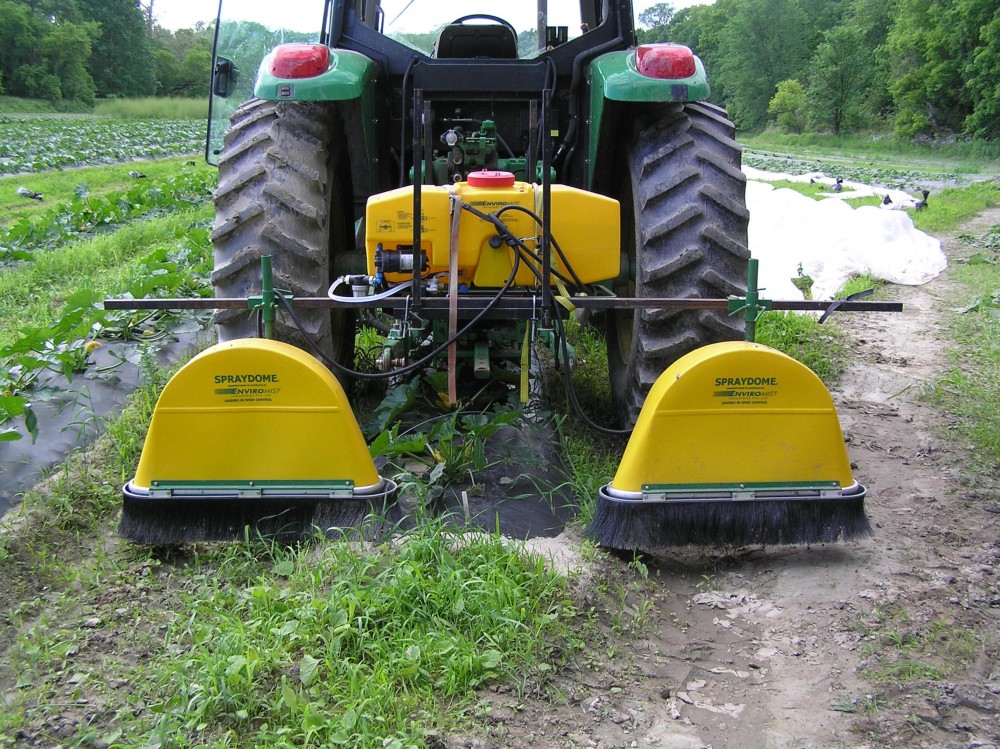Weed Control and Plastic Mulches
Chuck Bornt, Team Leader, Extension Vegetable Specialist
Eastern New York Commercial Horticulture
As the weather warms up and plastic mulches are being applied to get ready for our summer crop plantings, the question of what to do about weed control in the beds and between the beds is a common one that I get. Unfortunately, I don't have a silver bullet for you but have a couple of thoughts. First, there are a few herbicides that are labeled for use under the plastic on a few crops. However, the recommended use is to make the beds first, apply the herbicides and then lay the plastic mulch which is not usually how we manage our plasticulture systems - as we normally like to bed and mulch all in the same pass. I have yet to see anyone modify their mulch layer to apply herbicides while laying their mulches (if anyone has, please let me know I would love to see it!). The other thing to consider is that many of these products are very sensitive to moisture and often require it to activate them. Lastly, I worry about injury to our crop when using these herbicides, especially as many of you are using water-wheel transplanters which could in theory reactivate the herbicide and concentrate it around the rootball. I think educating your employees planting to make the smallest hole possible and making sure that plant gets off to a good start may be just as good as the pre-plant herbicides! However, if you want to try some herbicides under mulches this is what is labeled to my knowledge:
Herbicides Labeled for Use Under Plastic Mulch
Herbicide
Crop(s)
Devrinol
Tomatoes, Peppers, Eggplant
Prefar
Eggplant, Peppers, Cucumbers, Melons, Squash
Sandea
Tomatoes, Cucumbers, Melons, Squash, Watermelon (need to wait 7 days after application to plant crop)
Prowl H2O
Eggplant
So the other question that comes up is how to control weeds between the rows and again, I don't have a silver bullet, but there are certainly more options! The first thing that I would tell you is I do not recommend applying any of these materials broadcast over the top of your mulch before planting! I think you are taking a risk that even after a couple of rains, some of the herbicide may remain on the plastic and could concentrate in the planting hole after you've planted with a rain - especially in cases where beds are not uniformly full and you have dips in your beds where water can gather on the plastic. I think the best method is to fit the field, lay your plastic and then using either very directed sprays or better yet, a shielded sprayer, apply the herbicides between the beds, just letting the spray contact the shoulders of the bed. I've seen some homemade shielded units made from plastic totes to old wooden apple crates!
My rule of thumb for row middle applications is, if the material is labeled on the crop, then it can be used in the row middles too unless otherwise specified on the label that it cannot be used between the rows. Using a pre-emergent or combination of pre-emergents before transplanting is the best strategy in my mind as you minimize the risk of drift and hitting your crop. However, if you can't get right in there to apply them after laying your mulch or planting and weeds are already starting to grow, I would recommend tank mixing in a contact herbicide such as Gramoxone (or other formulations of the active ingredient paraquat) to your pre-emergent materials as a shielded, directed spray. Why paraquat instead of glyphosate (Round-Up etc.)? Paraquat will only kill what it comes in contact with (so coverage is essential). So if a little drift moves onto your plant, it will only kill the area that it comes in contact with and leave some tan spots. Whereas a small amount of glyphosate will translocate and potentially kill or really hurt your crop and I'd rather be safe than sorry.
Below is a list of some herbicides that could be used between rows of plastic mulch on various crops. This is not to be used in place of a label as in some instances a product may be labeled on some but not all crops in the same family (for example when I say brassicas, that includes cabbage, broccoli, etc., but these products may not be labeled on all members of the brassica family so please read the label before using).
Herbicides Labeled for Between Rows of Plastic Mulches on Various Vegetable Crops
Herbicide
Crop(s)
Dual Magnum (metolachlor)
Tomatoes, Peppers, Cucurbits, some Brassicas, Lettuce, Onion
Prefar (bensulide)
Eggplant, Peppers, Cucumbers, Melons, Squash, Brassicas, Lettuce
Sandea (halosulfuron)
Tomatoes, Cucumbers, Melons, Squash, Watermelon, Peppers, Eggplant
Prowl H2O (pendimethalin)
Eggplant, Pepper, Tomato, Onion, Brassicas
Reflex (fomesafen)
Tomatoes, Peppers, Eggplant,
Dimetric, Sencor (metribuzin)
Tomatoes
Strategy (clomazone + ethalfluralin)
Cucumber, Melon, Pumpkin, Squash
 Shielded sprayer manufactured by Crop Care (Photo: http://www.cropcareequipment.com)
Shielded sprayer manufactured by Crop Care (Photo: http://www.cropcareequipment.com) Hooded sprayer manufactured by Micron Sprayers Ltd and Enviromist Industries Pty.
Hooded sprayer manufactured by Micron Sprayers Ltd and Enviromist Industries Pty.
Upcoming Events
Ag Labor Road Show IX
December 1, 2025 : Save the Date! - Ag Labor Roadshow Webinar 1
In addition to the in-person Ag Labor Roadshow program in our region on December 9, two webinars are scheduled for December 1 and December 22. Each webinar will focus on different program content that is different from the in-person sessions. These webinars are an added benefit to program registration.
December 9, 2025 : Save the Date - Ag Labor Road Show In-Person Event (Greenwich, NY)
Greenwich, NY
The Roadshow delivers essential updates on labor law, regulations, and workforce best practices—tailored for farm owners, managers, and ag service providers. Sessions also focus on practical strategies to boost communication, strengthen retention, and build a positive workplace culture.
The in-person session for Eastern NY is December 9 - Elks Lodge, Greenwich, NY - full day in person session
Additional in-person sessions are:
December 10 - Hilton Garden Inn, Watertown, NY, December 17 - Cornell AgriTech, Geneva, NY, December 18 - Genesee Community College, Batavia, NY
December 22, 2025 : Save the Date! - Ag Labor Roadshow Webinar 2
In addition to the in-person Ag Labor Roadshow program in our region on December 9, two webinars are scheduled for December 1 and December 22. Each webinar will focus on different program content that is different from the in-person sessions. These webinars are an added benefit to program registration.
How to Obtain a Pesticide Applicator License
December 17, 2025
Thinking about becoming a certified pesticide applicator in New York, but aren't sure where to start? Join DEC representative Kenneth Klubek for a discussion on who needs to become a certified pesticide applicator, certification types, examination procedures, and recertification. Participants will have ample opportunity to ask questions during the program.
2026 Winter Cut Flower Webinar Series
January 6, 2026 : Session 1: Cut Flower Cost Calculator Updates and Woody Cuts
Session 1: Cut Flower Cost Calculator Updates and Woody Cuts
January 13, 2026 : Session 2: Perennials and Industry Trends
Session 2: Perennials and Industry Trends
January 20, 2026 : Session 3: Anaerobic Soil Disinfestation and Biochar
Session 3: Anaerobic Soil Disinfestation and Biochar
January 27, 2026 : Session 4: Beneficial Insects and Propagation Techniques
Session 4: Beneficial Insects and Propagation Techniques
February 3, 2026 : Session 5: Fungal and Insect Pests and Market Trends
Session 5: Fungal and Insect Pests and Market Trends












































